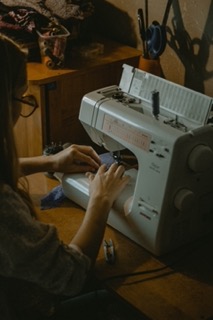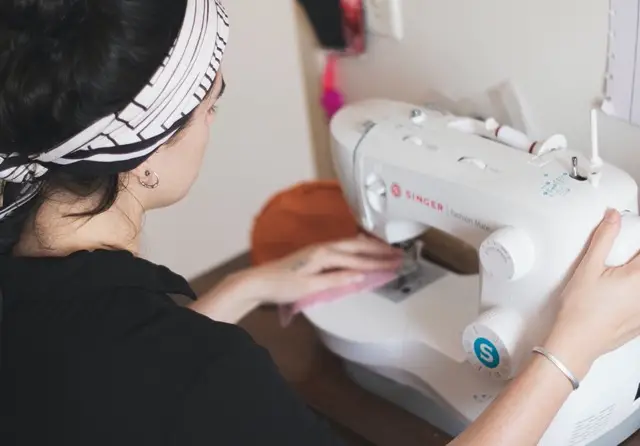We’ve all been there when this Question comes to our mind “How to UnFreeze a Sewing Machine” . You’re in the middle of a sewing project, and your machine just…stops. It’s frozen solid, and no matter how much you jiggle the handle or threaten it with a screwdriver, it just won’t budge. What do you do? Do you call a repairman? Do you give up on sewing altogether and take up basket weaving instead? Of course not! You unfreeze your sewing machine with these simple steps.
Basic Troubleshooting to UnFreeze A Sewing Machine

First, check to see if your machine is plugged in. Once you’ve verified that it is, take a look at the power cord. Is it frayed or damaged in any way? If so, that could be causing your machine to freeze up. The next thing to do is to check for any loose screws or bits of lint or thread that might be caught in the works. If everything looks clean and tight, it’s time to move on to the next step.
If your machine uses oil, make sure that it isn’t dry. Sewing machines need to be lubricated in order to work properly, and if yours is low on oil, that could be the reason why it isn’t working correctly. Another possibility is that the tension on your machine is too tight or too loose. Both of these problems can be easily fixed by consulting your sewing machine manual. Finally, if none of these solutions work, You can check the below guide.
- Check the power supply. The first thing you should do if your sewing machine freezes up is to check the power supply. If the machine is plugged into an outlets that is not working, the machine will not work. Check to make sure the outlet is working by plugging in another device. If the outlet is working, move on to the next step.
- Check for loose wires. Another reason why your sewing machine might be frozen is because of loose wires. Check all of the wires connected to your machine to make sure they are tight and secure. If any of the wires are loose, try tightening them or replacing them altogether.
- Clean the machine. Another reason why your sewing machine might be frozen is because it is dirty. Over time, lint and dust can build up inside the machine and cause it to freeze up. To clean your sewing machine, unplug it from the power source and remove any lint or dust from the surface with a soft cloth. Then, use a small brush to clean any lint or dust from inside the machine. Finally, use compressed air to blow any lint or dust out of hard-to-reach places.
- Take it to a professional. If you’ve tried all of the above steps and your sewing machine is still frozen, it might be time to take it to a professional for repairs. A professional will be able to diagnose the problem and fix it so you can get back to using your sewing machine as soon as possible.
With these simple steps, you can unfreeze your sewing machine and get back to work in no time! Just remember to check the power cord, look for loose screws or lint, add oil if necessary, and adjust the tension as needed. And if all else fails, don’t hesitate to call a professional for help.
How to Use Wd-40 to Unfreeze my Sewing Machine
If your sewing machine has frozen, there are a few things you can do to try and fix the issue. First, check to see if there is anything blocking the needle from moving. If there is, remove it and try again. If that doesn’t work, try using WD-40. Simply spray WD-40 onto the areas of the machine where you think the problem may be coming from. Wait a few minutes and then try using your machine again.
“When I was a little girl, my grandmother gave me a sewing machine as a birthday present. It was one of the most cherished gifts I ever received. Over the years, I used it to make all sorts of things: clothes for myself and my dolls, quilts, and even a patchwork blanket for my dog.”
One day, however, the sewing machine stopped working. I tried everything I could think of to get it going again: changing the needle, oiling it, adjusting the tension – but nothing worked. I resigned myself to buying a new sewing machine, until one day an idea occurred to me. What if I unfroze the sewing machine?
I know this might sound crazy, but hear me out. I used Wd – 40 on the Moving Areas , that might have caused the machine to freeze , and then i did some oiling after spraying wd-40 , after waiting for some time , i decided to start the machine and it worked. This solution worked for me , might be a chance it will work for you or it might not , you can try all the steps mentioned about at last if it still doesnt fix your sewing Machine you can go to Sewing Machine Repair Near you.
How to Repair a Sewing Machine in 7 Easy Steps!

Sewing machines are one of the most useful tools that a person can own. They can be used to make clothes, curtains, quilts, and so much more. But sewing machines, like any other tool, can sometimes break down. When that happens, it’s important to know how to repair them. Luckily, repairing a sewing machine is not as difficult as it might seem. With a little patience and the right instructions, anyone can fix a sewing machine.
Step one :First, take a look at your sewing machine. What seems to be the problem? Is the needle jammed? Is the thread tangled? Is the power light off? Identifying the problem is the first step to fixing it.
Step two :Once you’ve identified the problem, it’s time to get to work. If the needle is jammed, start by turning off the power to your sewing machine. Then, use a small screwdriver to carefully remove the needle. Once the needle is removed, clear any debris that may be blocking the path of the needle. Finally, re-insert the needle and turn on your sewing machine. The needle should now be working properly.
Step three :If the thread is tangled, begin by cutting away any tangled sections of thread. Be careful not to cut too much thread, as this may impact the tension of your stitches. Once you’ve cut away the tangled sections of thread, take a look at your bobbin. Is it full? If so, replace it with an empty bobbin. This will help prevent further tangling.
Step four :If the power light is off, check to make sure that your sewing machine is plugged into an outlet and that the switch is turned on. If it is plugged in and turned on, but the power light still isn’t working, there may be a problem with your fuse. To check if this is the case, locate your fuse box and find the fuse that corresponds to your sewing machine. If this fuse has blown, simply replace it with a new one and try again.
Step five: Check the Manual
Most sewing machines come with a manual that includes instructions on how to perform basic repairs. If your machine is covered by a warranty, this would be a good time to check and see if repairs are covered. If they are not, you can still use the manual to try and fix the problem yourself.
Step six: Clean and Oil the Machine
One of the most common reasons why sewing machines break down is because they are not properly maintained. To keep your machine in good working order, it’s important to clean and oil it on a regular basis. This will help prevent jams and other common problems. Oiling your machine is especially important if it’s been sitting for awhile without being used.
Step seven: Replace Broken Parts
Sometimes, no matter how well you maintain your machine, parts will still break down over time. If this happens, you’ll need to replace the broken part with a new one. Many common parts— such as needles and light bulbs—can be easily replaced at home. However, if the broken part is more complex—such as the motor or timing belt—it’s best to take the machine to a professional for repairs.
That’s it! By following these simple steps, you should be able to repair most common sewing machine problems without having to call a technician or take your machine into a shop for repairs. In no time at all, you’ll be back to stitching up a storm!
Conclusion:
If your sewing machine freezes up, don’t panic! There are several things you can try before taking it to a professional for repairs. First, check the power supply by plugging in another device into the same outlet . If that doesn’t work, check for loose wires and tighten them or replace them if necessary . Third , try cleaning the machine by removing any lint or dust from the surface with a soft cloth and using compressed air to blow any lint or dust out of hard-to-reach places . Finally , if none of these steps work , take it to a professional for repairs .
